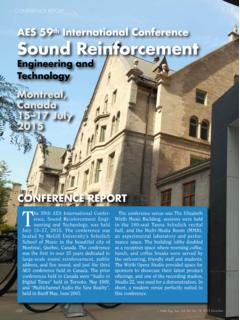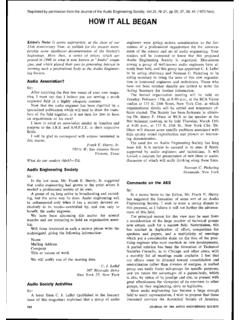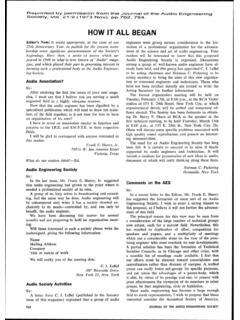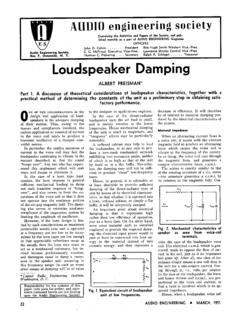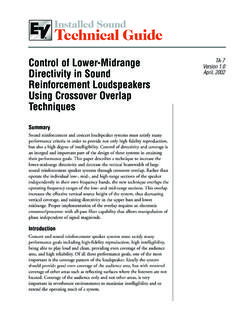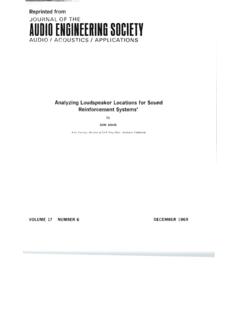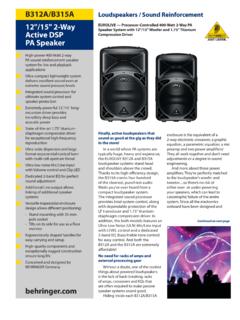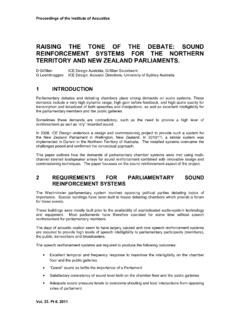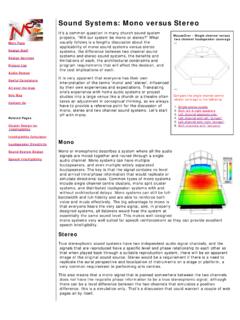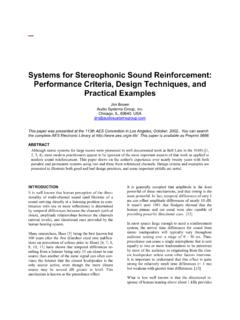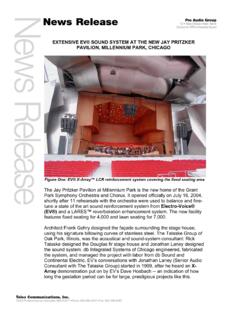Transcription of Sound Reinforcing Systems - AES
1 AUDIO engineering society Containing the Activities and of the Society, and pub- Sound Reinforcing Systems ARTHUR W. SCHNEIDER* A discussion of a variety of problems that arise in the installation of these Systems in large halls. S OUND Reinforcing is not, in tlie strict sense of the word, public address. It is an electro-acoustic system of amplifying and converting sounds into acoustic energy in such a fashion as tc aid the uriginal Sound and to permit comfortable listening. A Sound Reinforcing system ii not a reproducer of Sound , nor is it a producer of Sound . Fundamentally, the approach to a Sound Reinforcing system and the analysis of a Sound Reinforcing problem depends on Sound reproducers and Sound producers. A Sound reproducer is something which picks up a Sound , amplifies it, and reproduces it so that the Sound is as near to the original as possible.
2 In this process no latitude should be taken by the engineer or the user to modify the original Sound , even though this mdifi- cation may make the Sound more pleas- ing. In a case where latitude is taken to modify the nature of the original Sound , th'en the instrument is no longer a reproducer of Sound but becomes a producer of Sound . For instance, Ham- mond organs and electric guitars are essentially producers of Sound , whereas broadcast studios, transmitters, and ra- dio receivers are essentially reproducitig networks. A Sound Reinforcing system , how- ever, is neither one of these, but a com- bination of both in view of the fact that it is necessary to add to the original Sound so that the original Sound plus the amplified Sound will make it Sound to the auditor as if it were all original Sound . Therefore. in the ~erfect Sound Reinforcing system , this blending of the amplified Sound plus the original Sound gives the auditor a feeling of comfort- able listening without his realizing that amplification is being made.
3 From these statements it is readily seen that the art of Sound Reinforcing is applicable primarily to large halls and outdoor places of entertainment. It is also interesting to note that the art of Sound Reinforcing is relatively young. It has ,originated since the advent of tlie microphone, loudspeaker, and amplifier. As a matter of fact, to the writer's knowledge, no outstanding installations of Sound Reinforcing Systems were in use prior to 1931. Our forefathers were able to get around this fact by develop- ing people with high acoustic output, and we cherish the memories of such porducers of Sound as Caruso and Wil- liam Jennings Bryan. Now, through the efforts of Sound engineers, we have dc- veloped a crop of singers who croon and politicians who whisper into KB2C9s. system Requirements Let us now consider the requirements of the so-called perfect Sound reinforc- ing system , or at least the requirements of a system that would fill all the desired and ideal functions.
4 The first require- ment is for a system to amplify all sounds on the stage regardless of whcrc: these sounds originate, and to amplify them with sufficient intensity for the audience to hear comfortably before feedback occurs. Feedback, of course, occurs when the Sound returning to :he microphone frbm the loudspeaker is equal to the original sounds. The second requirement of the perfect Sound reiii- forcing system is that all sounds he amplified and reproduced equally insofar as the frequency response is concerned. The third requirement is that the wave form characteristics of the Sound he preserved, that is, that the reproduced sounds be relatively free from distortion. The fourth requirement is that the illu- sion be preserved. This, of course, is a selves in the illusion of what is going on, and surely the illusion would not be preserved if the sounds appeared to come from any spot other than where they are produced.
5 The last requirement of a Sound Reinforcing system --one without which an otherwise good sys- , tem will cease to be good--concerns the acoustics of the hall in which the system is to be installed and the attention of the design engineer to these acoustic prob- lems. It is not possible to install a perfect Sound Reinforcing system for many reasons, and numerous con~promises must be effected. In order to get suffi- cient amplification before feedback, the characteristics of the microphoncs should be such as to limit their range of pickup to the area in which the sounds are being produced. In general, directional microphones are needed with norillal pickup from the stage side and little from the audience side. These go a long way toward increasing the maxi- mum usable gain. Loudspeakers On the speaker side, a directional unit is required so that the sounds produced can be directed into the audience area with a minimum of Sound being returned to the microphone.
6 However, a dircc- tional horn to cover the low end of the spectrum is impractical because of ~ts size. Fortunately, this limitation is not serious in view of 'the fact that most. sounds below 150 cps produced in the theater are of a sufficient intensity as not to require much Sound Reinforcing . Therefore, ySru will find that in most Sound Reinforcing Systems the emphasis is laid on those frequencies extending upward from the fundamental of the male voice. At the high-frequency end of the most important factor when it comes to spectrum. some compromises have to be * General Manager, Commercial Radio- 231 E. 47tk s$., New Yo,,k 17, show business. The basic reason for effected in the loudspeaker design. Se- N. Y. people going to theaters is to lose them- lection is limited, in view of the fact AUDIO ENGINEERING NOVEMBER, 1950 Audio Engineering Society Section that best-known over-all reproducers of Sound are of the cone type, which is not readily adaptable to a directional loud- speaker.
7 The loudspeakers on the high end should be of the cellular type, giving a uniform distribution to the high-fre- quency sounds. The microphones should have a directional characteristic pattern that limits the pickup to the area in which the sounds are being produced. However, in a good Sound Reinforcing system it if best that the microphone be concealed, inasmuch as it is not de- sirable to advertise the fact that the Sound is being amplified, because this in turn would spoil the illusion. Therefore, it is necessary to conceal microphones in footlights and similar places, which results in a compromise in quality, di- rectional characteristics, and scope of pickup. If microphones are concealed for reasons of illusion, it is necessary that the speakers be concealed also if a good illusion is to be preserved from an audience standpoint.
8 However, in con- nection with the speakers, their con- cealment is not the only consideration when it comes to illusion. It is necessary to have the speaker within a reasonable distance of the Sound -producing source and located in such a manner as to make it appear to the auditor that the Sound is actually coming from the Sound -pro- ducing device and not from the loud- speaker. In general, the difference 111 the path length between the actual Sound and the Sound coming from the loud- speaker should not be greater than 60 to 80 feet. If this distance is greater than 80 feet, the auditor perceives that the Sound is not actually coilling from the producer of the Sound , but from an- other spot. As this distance is increased, this realization becomes more acute. Compromises have to be affected in this particular category to a much greater degree than in any phase of Sound re- inforcing.
9 It is only with the distinct help of the architect in connection with the de- sign that illusion can be preserved. Com- plete cooperation between the Sound en- gineer and the architect is a matter of great importance. To date, too few architects have realized the problenls of , the Sound engineer and have given too much attention to the appearance of the halls rather than to utilitarian value. After all, if a room is designed so that it is impossible to see or td hear properly, then it has little use as a meeting hall or a theater. The two fundamentals of a good auditorium are good vision and good hearing. Once these two objectives ' are obtained, then specification for fancy chandeliers, paintings, and other decora- tive elements lose their importance. One example of a wonderful illusion was in the "Great Waltz," a show at the Center Theater back in 1933.
10 The size of the proscenium was cut down consid- erably, and in the center of this there was a large emblem of the double eagle. It was behind this emblem that the Sound Reinforcing horns were placed. In all parts of the theater, it appeared as though the Sound were coming from the actual singers and orchestra. The frequency response of the ampli- fier, microphones, and speaker is an important phase of Sound Reinforcing . Too much emphasis has been laid on the range of the system rather than the smoothness of response. It is much bet- ter to have a system with a limited range and a close tolerance of the output over this range than one with an extended range and large variation in the out- put over the range. < When feedback occurs, it occurs at the frequency at which the system peaks. If there is a large peak at some par- ticular point, feedback will occur even though the average energy content over the entire frequency range is relatively small.
